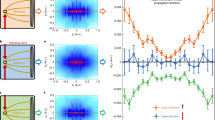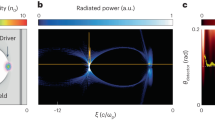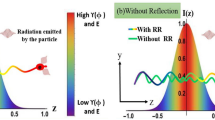Abstract
A charged particle exposed to an oscillating electric field experiences a force proportional to the cycle-averaged intensity gradient. This so-called ponderomotive force1 plays a major part in a variety of physical situations such as Paul traps2,3 for charged particles, electron diffraction in strong (standing) laser fields4,5,6 (the Kapitza–Dirac effect) and laser-based particle acceleration7,8,9. Comparably weak forces on neutral atoms in inhomogeneous light fields may arise from the dynamical polarization of an atom10,11,12; these are physically similar to the cycle-averaged forces. Here we observe previously unconsidered extremely strong kinematic forces on neutral atoms in short-pulse laser fields. We identify the ponderomotive force on electrons as the driving mechanism, leading to ultrastrong acceleration of neutral atoms with a magnitude as high as ∼1014 times the Earth’s gravitational acceleration, g. To our knowledge, this is by far the highest observed acceleration on neutral atoms in external fields and may lead to new applications in both fundamental and applied physics.
This is a preview of subscription content, access via your institution
Access options
Subscribe to this journal
Receive 51 print issues and online access
$199.00 per year
only $3.90 per issue
Buy this article
- Purchase on Springer Link
- Instant access to full article PDF
Prices may be subject to local taxes which are calculated during checkout



Similar content being viewed by others
References
Kibble, T. W. B. Refraction of electron beams by intense electromagnetic waves. Phys. Rev. Lett. 16, 1054–1056 (1966)
Boot, H. A. H. &. Harvie, R. B. R.-S. Charged particles in a non-uniform radio-frequency field. Nature 180, 1187 (1957)
Dehmelt, H. G. Radio-frequency spectroscopy of stored ions. Adv. At. Mol. Phys. 3, 53–72 (1967)
Kapitza, P. & Dirac, P. The reflection of electrons from standing light waves. Proc. Camb. Philos. Soc. 29, 297–300 (1933)
Bucksbaum, P. H., Schumacher, D. W. & Bashkansky, M. High-intensity Kapitza-Dirac effect. Phys. Rev. Lett. 61, 1182–1185 (1988)
Freimund, D. L., Aflatooni, K. & Batelaan, H. Observation of the Kapitza-Dirac effect. Nature 413, 142–143 (2001)
Tajima, T. & Dawson, J. M. Laser electron accelerator. Phys. Rev. Lett. 43, 267–270 (1979)
Geddes, C. et al. High-quality electron beams from a laser wakefield accelerator using plasma-channel guiding. Nature 431, 538–541 (2004)
Mourou, G., Tajima, T. & Bulanov, S. Optics in the relativistic regime. Rev. Mod. Phys. 78, 309–371 (2006)
Gould, P. L., Ruff, G. A. & Pritchard, D. E. Diffraction of atoms by light: The near-resonant Kapitza-Dirac effect. Phys. Rev. Lett. 56, 827–830 (1986)
Chu, S., Bjorkholm, J. E., Ashkin, A. & Cable, A. Experimental observation of optically trapped atoms. Phys. Rev. Lett. 57, 314–317 (1986)
Grimm, R., Weidemüller, M. & Ovchinnikov, Y. Optical dipole traps for neutral atoms. Adv. At. Mol. Phys. 42, 95–170 (2000)
de Boer, M. P. & Muller, H. G. Observation of large populations in excited states after short-pulse multiphoton ionization. Phys. Rev. Lett. 68, 2747–2750 (1992)
Nubbemeyer, T., Gorling, K., Saenz, A., Eichmann, U. & Sandner, W. Strong-field tunneling without ionization. Phys. Rev. Lett. 101, 233001 (2008)
Corkum, P. B. Plasma perspective on strong field multiphoton ionization. Phys. Rev. Lett. 71, 1994–1997 (1993)
Krapchev, V. B. Kinetic theory of the ponderomotive effects in a plasma. Phys. Rev. Lett. 42, 497–500 (1979)
McNaught, S. J., Knauer, J. P. & Meyerhofer, D. D. Photoelectron initial conditions for tunneling ionization in a linearly polarized laser. Phys. Rev. A 58, 1399–1411 (1998)
Wells, E., Ben-Itzhak, I. & Jones, R. R. Ionization of atoms by the spatial gradient of the pondermotive potential in a focused laser beam. Phys. Rev. Lett. 93, 023001 (2004)
Batelaan, H. Illuminating the Kapitza-Dirac effect with electron matter optics. Rev. Mod. Phys. 79, 929–941 (2007)
Chu, S. Nobel lecture: The manipulation of neutral particles. Rev. Mod. Phys. 70, 685–706 (1998)
Stapelfeldt, H., Sakai, H., Constant, E. & Corkum, P. B. Deflection of neutral molecules using the nonresonant dipole force. Phys. Rev. Lett. 79, 2787–2790 (1997)
Fulton, R., Bishop, A. I. & Barker, P. F. Optical Stark decelerator for molecules. Phys. Rev. Lett. 93, 243004 (2004)
Henneberger, W. C. Perturbation method for atoms in intense light beams. Phys. Rev. Lett. 21, 838–841 (1968)
Quesnel, B. & Mora, P. Theory and simulation of the interaction of ultraintense laser pulses with electrons in vacuum. Phys. Rev. E 58, 3719–3732 (1998)
Eberly, J. H., Javanainen, J. & Rzazewski, K. Above-threshold ionization. Phys. Rep. 204, 331–383 (1991)
Acknowledgements
We thank F. Noack for technical support on the laser system and W. Becker, P. B. Corkum, H. R. Reiss and O. Smirnova for discussions.
Author Contributions U.E. and T.N. designed and performed the experiments and analysed the data. All authors contributed to the theoretical understanding and were involved in the completion of the manuscript.
Author information
Authors and Affiliations
Corresponding author
Rights and permissions
About this article
Cite this article
Eichmann, U., Nubbemeyer, T., Rottke, H. et al. Acceleration of neutral atoms in strong short-pulse laser fields. Nature 461, 1261–1264 (2009). https://doi.org/10.1038/nature08481
Received:
Accepted:
Issue Date:
DOI: https://doi.org/10.1038/nature08481
This article is cited by
-
Study of the effect of higher-order dispersions on photoionisation induced by ultrafast laser pulses applying a classical theoretical method
Scientific Reports (2022)
-
Interference patterns in ionization of Kramers–Henneberger atom
Scientific Reports (2022)
-
Observation of the ponderomotive effect in non-valence bound states of polyatomic molecular anions
Nature Communications (2021)
-
Intensity modulation of the population of atomic excited states by using near-infrared femtosecond laser pulses
Journal of the Korean Physical Society (2021)
-
Optical trapping of antihydrogen towards an atomic anti-clock
Hyperfine Interactions (2020)
Comments
By submitting a comment you agree to abide by our Terms and Community Guidelines. If you find something abusive or that does not comply with our terms or guidelines please flag it as inappropriate.



